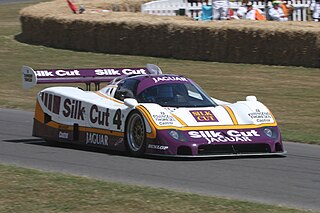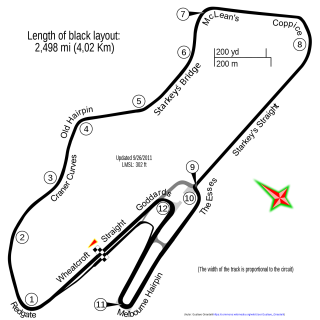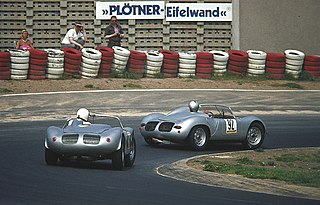
The Porsche 718 is a series of one- or two-seat sports-racing cars built by Porsche from 1957 to 1962. An open-wheel single-seat model was developed for Formula racing.
Gary Thomas Brabham is a former professional racing driver from Australia and a British Formula 3000 champion.

The RS Spyder is a racing car designed by Porsche in conjunction with Penske to compete in Le Mans Prototype Class 2 (LMP2) racing. The car takes its name from the legendary 550 Spyder of the 1950s. The car marked Porsche's first return to the top level of sports prototype racing since the firm abandoned its Porsche LMP in 1999.
Guy Smith is a semi-retired British professional racing driver who has competed in various levels of motorsport, most notably the 24 Hours of Le Mans, which he won in 2003, and the American Le Mans Series, which he won in 2011.
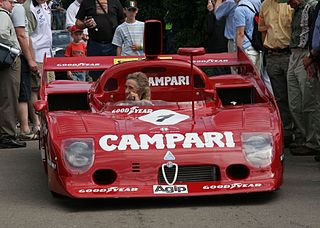
The Alfa Romeo Tipo 33 was a sports racing prototype raced by the Alfa Romeo factory-backed team between 1967 and 1977. These cars took part for Sport Cars World Championship, Nordic Challenge Cup, Interserie and CanAm series. A small number of road going cars were derived from it in 1967, called Alfa Romeo 33 Stradale.
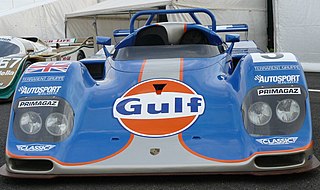
The Kremer K8 Spyder, along with its predecessor, the K7 (1992-1993), were open-cockpit prototypes built by Kremer Racing for use in multiple sportscar series, such as the IMSA GT Championship, Interserie, and International Sports Racing Series. The cars shared many components from the retired Porsche 962 and would eventually go on to win the 24 Hours of Daytona and several championships.
Dauer Sportwagen GmbH was a German automotive company founded by former racing driver Jochen Dauer in Nuremberg. Initially founded as Jochen Dauer Racing in 1987, the racing team had several years of participation in the German Supercup and European Interserie championships, as well as occasional runs in the World Sports-Prototype Championship and Camel GT Championships with the Porsche 962. Following the demise of sports prototype racing in the early 1990s, Dauer Racing GmbH was created to begin limited production of road cars, including a road-legal version of the 962, known as the Dauer 962 Le Mans, which later went on to win the 1994 24 Hours of Le Mans. Once changing to Dauer Sportwagen, the company sold a continuation of the Bugatti EB110. The company went bankrupt in 2008 and parts for the EB110 were transferred to Toscana-Motors GmbH.
Walter Lechner Racing is an auto racing team based in Austria. It is also known as the Lechner Racing School and offers customers their first insight into the motorsport world and aims to discover new driver talents.

Robin Donovan is a British former racing driver. He is best known for competing in 14 editions of the Le Mans 24 hours race; his best result there being 6th overall, 3rd in class (LMP1) and 1st privateer home driving with 5 x Le Mans winner Derek Bell MBE and Daytona 24 hours winner Jurgen Lassig in 1994 with the Gulf Racing entered and sponsored Kremer Porsche K8.
Gary Chalandon is a French racing driver. He is most notable for competing in the 24 Hours of Le Mans, Formula Le Mans Cup and the Le Mans Series. He won the Formula Le Mans class of the Le Mans Series in 2010, whilst driving for DAMS.
Centenari Racing SRL, usually referred to as Centenari, was an Italian racing team and chassis constructor company based in Italy, predominantly building sports prototypes. The team were active in international events between 1997 and 2006, having started off in national events in 1991.
The Centenari Mac3 was a Le Mans Prototype, originally built by Centenari in 1998 for the CN category of the International Sports Racing Series. It was updated in 2006, and the new version was renamed as the MG3. Both cars used the same naturally-aspirated 3.0 L Alfa Romeo V6 engine. The Mac3, in conjunction with the older M1 model, helped Centenari to take joint-second in the 1998 International Sports Racing Series CN Team's Championship.
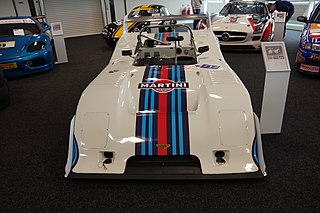
The Chevron B31 was a sports prototype racing car built by Chevron Cars Ltd in 1975, and initially used in the European 2-Litre Championship. The car was an evolution of the Chevron B26, and was initially fitted with a 2-litre Hart 420R straight-four engine producing 290 hp. However, various other engines were used; the car also ran with engines such as the 3-litre Cosworth DFV V8, the 2-litre Cosworth FVD/Cosworth BDG straight-four engines, and the 2-litre BMW M12 straight-four, amongst others.

The Spyder NF-10 was an American sports prototype racing car built for the Can-Am series in 1978. It was based on a Lola T333CS, and was developed into the Spyder NF-11 in 1979. Two NF-10s were built in 1978, whilst four NF-11s were built in 1979, two of which were originally NF-10s. Both the NF-10 and NF-11 featured a 5-litre Chevrolet V8 engine.
The Debora SP93 was a C3 class sports-prototype built by Debora for hillclimbing and for the French Coupe Alfa Romeo. It was updated to the Debora LMP294 in 1994 for the same event. Both cars were fitted with a 3-litre Alfa Romeo V6 engine, and both were run at the 24 Hours of Le Mans by Didier Bonnet Racing. Only two chassis, #C393-01 for Le Mans and #C393-02 for the "Coupe Alfa Romeo", were built, and were used for both the SP93 and the LMP294.
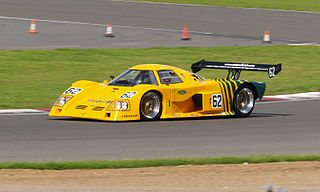
The Ford C100 is a sports racing car, initially built and run as a Group 6 car, but later as a Group C car. The C100 was built by Ford in 1981, and initially featured a 4-litre Cosworth DFL V8 engine, which was replaced by a 3.3-litre version of the same engine in 1983, after the car had passed to private hands. Five cars are known to have been built. Although the cars were often very quick in qualifying, reliability problems plagued them, and restricted their successes to two Deutsche Rennsport Meisterschaft victories in 1982, and a single Thundersports victory in 1983. Following the end of Ford's involvement in the C100 project in 1983, Zakspeed modified one of the chassis into the C1/4, which used a 1.8-litre turbocharged in-line 4 from their Group 5 Ford Capri. The C100 was also evolved into the Zakspeed C1/8, which used the 4-litre Cosworth DFL in a C1/4 chassis. The Zakspeed cars would prove to be far more successful than the C100 had ever been, and Klaus Niedzwiedz used a C1/8 to win the Interserie in 1984.
The Lotec 681 was a sports prototype racing car, built by Lotec in 1981. Fitted with a BMW M88 straight-six engine, the car had a reasonably successful, albeit very brief, career before it was replaced by the Lotec M1C in 1982. One car was built.
The Cheetah G603 was a Group C sports racing car built by Cheetah Automobiles in 1983. One car was built, and it was fitted with a 4-litre Cosworth DFL V8 engine; it had a short and fairly unsuccessful season before being replaced by the even less successful Cheetah G604 in 1984.
The McLaren C8 was a Group C racing car built in 1982. Starting out life as a 1972 McLaren M8F, the C8 used a 454 cu in (7,440 cc) Chevrolet V8 engine. The car proved to be fragile, and it often retired from races. Peter Hoffmann owned the sole C8, and ran it until 1999.

Willibert "Willi" Kauhsen is a German former racing driver and racing team owner from Eschweiler in Aachen, Germany.
